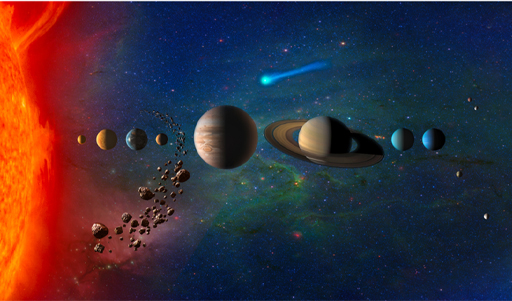1.2 Where did we come from?
Finding evidence of life beyond Earth is not the only reason why we want to explore the Solar System and not the only reason why we need to protect other planetary bodies. It is impossible to go into details of all the objectives of all exploration missions that have been launched over the last decades, but one strong theme among them is the quest for understanding how the Earth, and our Solar System more broadly (Figure 4), formed and evolved.

Our Solar System formed 4.65 billion years ago, with the planets, asteroids, comets and other objects forming from within a swirling disk of gas and dust with the Sun at the centre. Since their formation, many of the planets have experienced processes that have destroyed or changed the original materials from which they were formed – you may be aware of the tectonic processes that operate on Earth that destroy and create the planet’s crust – but some asteroids and comets have not experienced these processes. These objects retain chemistry and solid components that were formed when the Solar System was very young and can provide clues to its formation. Importantly, this includes the molecular building blocks of life.
-
What element are the molecular building blocks of life mainly composed of?
-
Carbon is the common element, being the basis for the organic molecules from which all life is formed.
-
Can you name any molecular building blocks? (Hint: you met some in Section 1.1.2!)
-
You might have remembered some of the larger molecular building blocks like lipids, proteins and nucleic acids, or some of the smaller ones such as amino acids. But this list is not exclusive!
Organic molecules are not just associated with life, or even with Earth – they are ubiquitous throughout the cosmos, being found throughout our Solar System and beyond. And it is proposed that these building blocks may have been delivered to the early Earth by impacts from meteorites (fragments of asteroids) or comets as they would not have survived the planet-building processes that formed the Earth. It is also believed that these building blocks, along with components such as water, would have been delivered to other planetary bodies, including our Moon.
Determining which molecules may have come from space and which may be biosignatures is really challenging, so it is important that this is not further complicated by introducing organic molecules from Earth, such as those sourced from the spacecraft manufacturing process (like lubricants or through the degradation of materials) or those that may be remnants of organisms inadvertently carried onboard.
Planetary protection is predominantly concerned with the transfer of life, however understanding what organic molecules might be carried with a spacecraft has become increasingly important. You will learn more about this later.
